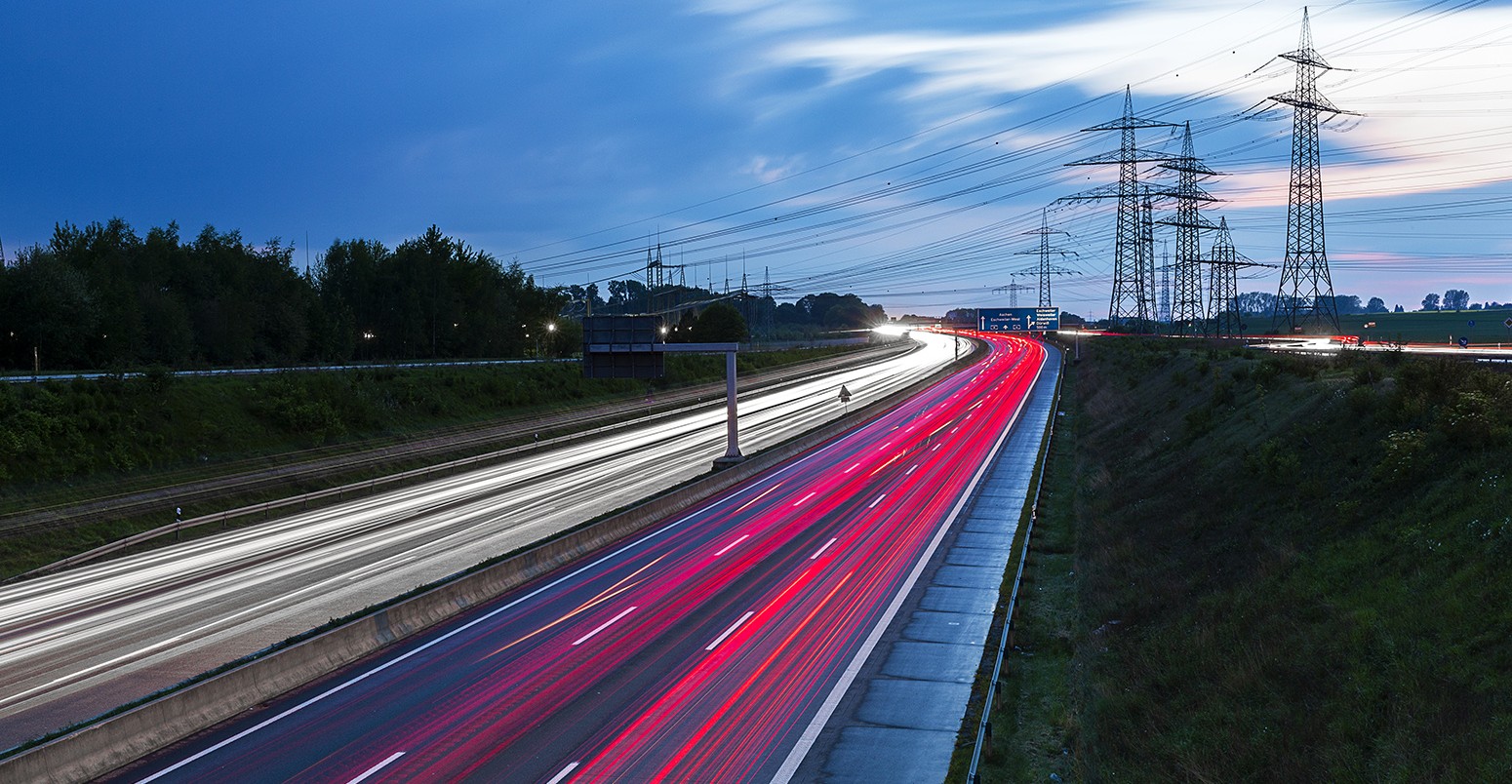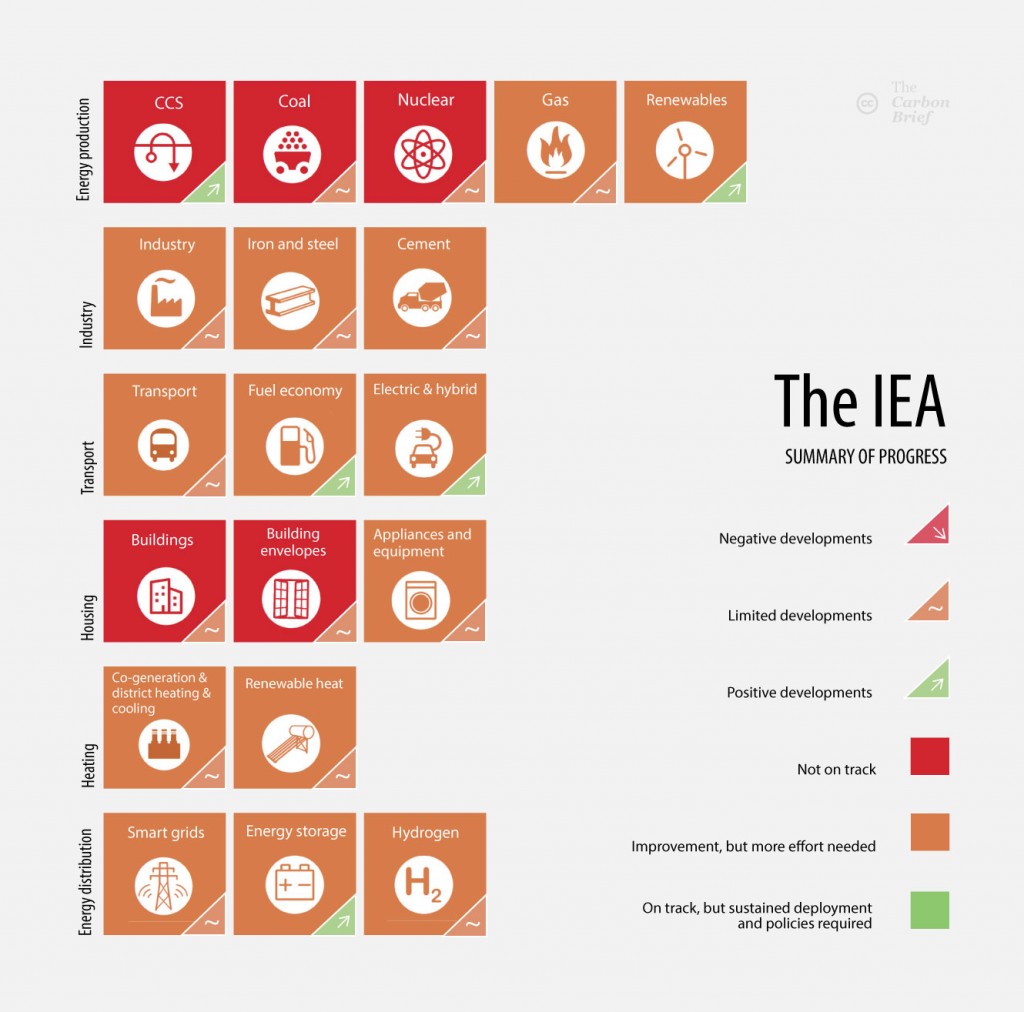
19 reasons why the world is missing the 2C climate change limit
Simon Evans
05.07.15Simon Evans
07.05.2015 | 9:45amThe world is falling further behind the goal to avoid more than 2C of global warming despite rapid progress in renewables and other areas, according to a new assessment from the International Energy Agency (IEA).
For the first time since it started tracking progress, none of 19 key areas for tackling climate change are on track to meet their contribution towards a sub-2C world, says the IEA’s Energy Technology Perspectives 2015, published on 4 May. It says five technologies or sectors are off track, and the outlook for the remaining 14 is failing to improve fast enough.
Carbon Brief has summarised the mammoth 412-page assessment in a single graphic, which shows where progress is falling furthest behind the path to 2C, and where there are rays of hope.
Avoiding dangerous climate change
The IEA report is based around three scenarios of the future between now and 2050, resulting in 2C, 4C or 6C of warming by the end of the century compared to pre-industrial times. The 6C scenario is largely a continuation of current trends. The 4C scenario takes account of existing climate pledges and the 2C one shows how energy and emissions trends would need to change to secure a 50/50 chance of avoiding 2C.
Using separate models for energy supply, buildings, transport and industry, the IEA draws out climate milestones for key areas needed to avoid dangerous warming. It says action is required on all fronts because no single technology or sector can solve climate change alone.
Under the business-as-usual 6C scenario, energy-related emissions would increase to around 55 billion tonnes of carbon dioxide in 2050 (the top line in the area graph, below). The coloured areas show the ways emissions could be reduced to put the world on a 2C path, with energy efficiency (orange) and renewables (green) playing the most significant roles.

The technologies and sectors making the largest contributions to shifting the world from a 6C to a 2C path between now and 2050. Source: IEA Energy Technology Perspectives 2015.
The bar chart above shows how important it will be to decarbonise the power sector, where the largest share of emissions reductions compared to business as usual need to be achieved. In other sectors, energy efficiency savings dominate.
Straying off course
So, how are things going with that 2C target? The IEA tracks recent progress in 19 key technologies and sectors to see how they are measuring up against its 2C milestones. Looking at the next decade to 2025, the IEA says every milestone is at risk of being missed.
Five areas, carbon capture and storage (CCS), coal, nuclear, building energy use and building energy efficiency are all off track, the IEA says (red squares, below).
The remaining 14 areas including renewables, industry, transport, electric vehicles, energy storage and hydrogen have seen improvements, but need to progress faster if they are to hit their climate milestones (orange squares).
The gloomy outlook is moderated for some areas, such as CCS, where recent developments have been more positive (green arrows). For instance, renewable power production will increase by half between 2013 and 2020, the IEA says, with some green sources now competitive with new fossil generation in come countries.
Progress in key technologies and sectors against climate milestones for a below-2C future. Source: IEA Energy Technology Perspectives 2015. Summary chart by Carbon Brief.
The IEA has been publishing its traffic-light assessment of clean energy progress since 2012. In that year, it rated five areas as off track (red) and a further three as needing improvement (orange). Only one area, renewable power, was on track (green). The 2015 tracker is the first with no areas rated green overall.
What needs to change
The list of improvements recommended by the IEA is lengthy and detailed. Just a few examples show the scale and range of effort needed to turn things around. The IEA says the amount of carbon dioxide being captured and stored each year through CCS needs to increase ten-fold.
Electricity prices must reflect the true cost of generation, with carbon pricing to make low-carbon sources competitive with coal. Uncertainty over renewables policy, particularly in the EU, is the main barrier to deployment. Financing costs are increased by policy uncertainty, the IEA says, and this can directly undermine renewables’ competitiveness.
The report stops short of demanding an early end to unabated coal, but says all new coal plants should be designed to allow for CCS in future, with a plateau and then reduction in coal emissions. Industrial energy use must fall by 1% every year to 2025 compared to current trends.
Transport emissions, increasing 2% per year since 2000, need to start falling. The current average 50% annual growth in electric vehicles needs to reach 80% per year. Between 1.5 and 2% of existing buildings need to have deep energy retrofits every year, to reduce energy consumption.
Historical perspective
The latest IEA report recommends a series of more or less familiar policy prescriptions to turn things around and put the world on track to avoid 2C of warming.
For readers of the first Energy Technology Perspectives report in 2006, there will be few surprises. The first edition noted agreement among the G8 group of leading nations to act with “resolve and urgency” on climate. At the time, G8 ministers asked the IEA to “help bridge the gap between what is happening and what needs to be done”.
The 2006 report said the world was not on course for a sustainable energy future, but that this “alarming outlook” could be changed. It said:
“The analysis demonstrates that a more sustainable energy future is within our reachâ?¦ [But] urgent action is needed to stimulate R&D, to demonstrate and deploy promising technologies, and to provide clear and predictable incentives for low carbon options and diverse energy sources.”
In a foreword to the 2015 report, Maria van der Hoeven, IEA executive director says:
“Never has the promise of clean energy technology been so great. Yet, ETP 2015 also highlights that never have the challenges surrounding deployment of the proper solutions been so daunting. We need to start thinking differently about what we can do to change the current sluggish pace towards sustainable change: we need to innovate!”
Like the 2006 version, the 2015 press release and executive summary highlight the need for enhanced spending on research and development so as to “mobilise innovation to accelerate climate action”. It says research spending should more than triple.
One relatively novel idea is to reframe climate goals around energy instead of temperatures. Instead of temperature or emissions targets, the IEA suggests looking at energy efficiency, clean power investment or research funding. This could “support ambitious, yet realistic targets”, it says.
Specific goals like these don’t appear in the draft text of a global climate deal set to be agreed by governments meeting in Paris at the end of the year. But even if the IEA’s recommendations are adopted in part or only by certain countries, there’s a chance next year’s outlook for the climate might be more favourable.


